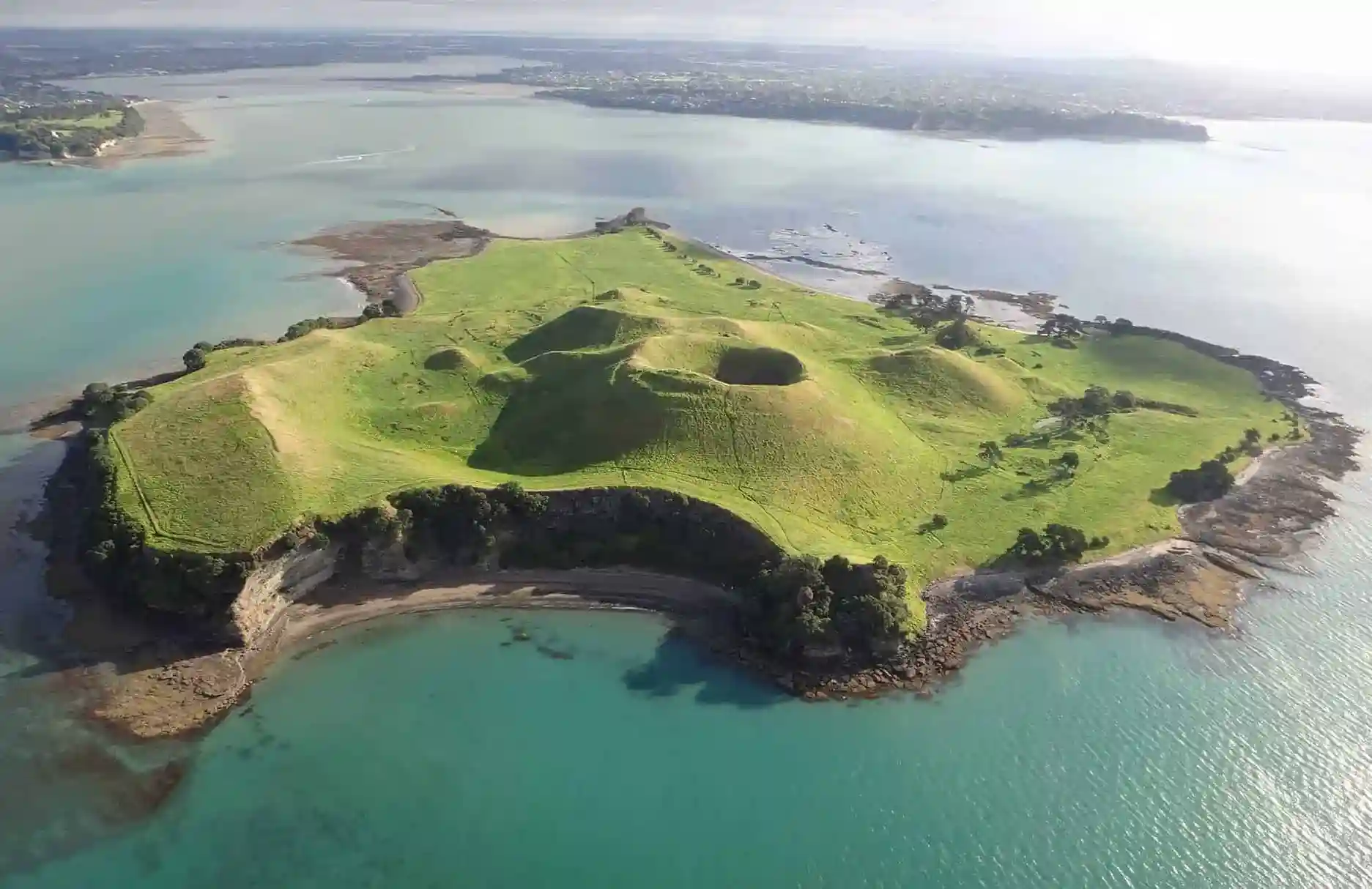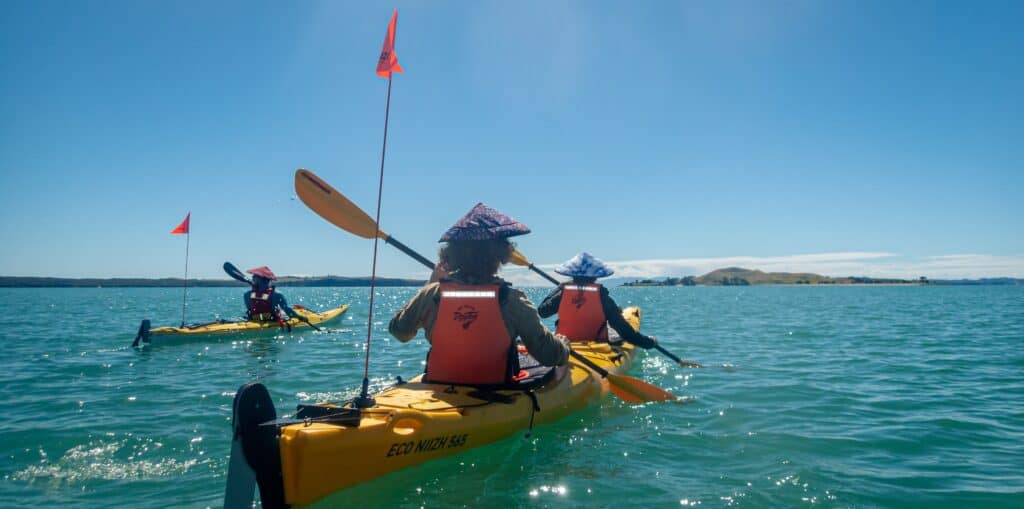August 14, 2024

Nestled in the tranquil waters of Auckland’s Hauraki Gulf, Motukorea, commonly known as Browns Island, is a volcanic treasure waiting to be explored. This small yet significant island is part of the Hauraki Gulf Marine Park, which became Auckland’s newest regional park and first island public reserve in February 2018. Rich in history and geological marvels, Motukorea Browns Island offers visitors a unique blend of natural beauty and cultural heritage, making it an ideal destination for outdoor enthusiasts, history buffs, and those seeking a peaceful escape from the city.
Browns Island Motukorea is one of the best-preserved volcanoes in the Auckland volcanic field, with an eruption history dating back approximately 25,000 years. The island’s volcanic origin is evident in its dramatic landscape, featuring a prominent scoria cone, deep craters, and remnants of a tuff ring. The initial eruption was explosive, creating a shallow 1-kilometer-wide crater. Over time, successive fire-fountaining eruptions built the scoria cones that dominate the island today.
The island’s volcanic past is not just a geological curiosity but also a living laboratory. The unique combination of volcanic landforms, such as the collapsed lava cave depression on the northwestern flats, and fossils like the Sydney mud cockle (Anadara trapezia) embedded in shell beds, provides valuable insights into the region’s prehistoric environment. These features are visible and accessible, allowing visitors to witness the raw power of nature that shaped this land.
Motukorea’s history is as rich and varied as its geological features. The island’s name, derived from the Māori word “korea,” meaning oystercatcher, reflects its longstanding association with these coastal birds, which still inhabit the island today. Māori occupation of Browns Island Motukorea dates back several centuries, with evidence suggesting the island was an important site for gardening, fishing, and stone tool manufacturing.
Archaeological surveys have identified three pā (fortified villages) on the island, alongside archaic middens, fish traps, and stone structures. These remnants of early Polynesian settlement illustrate the island’s role as a vital hub in the pre-European era. The island’s location at the mouth of the Tāmaki River was strategically important, controlling access to the river and the vital portages that connected the east and west coasts of New Zealand’s North Island.
In the early 19th century, European settlers recognized Motukorea’s potential. William Brown and Logan Campbell, regarded as the founding fathers of Auckland, purchased the island in 1840. They established one of Auckland’s first European settlements here, using the island as a base for farming and supplying the burgeoning town of Auckland. Their settlement marked the beginning of a new chapter in the island’s history, intertwining it with the story of Auckland’s development.
Browns Island Motukorea is not only significant for its natural and historical features but also for its cultural landmarks, which have become points of interest for visitors exploring the island by the Browns Island Kayak Tour. Among these landmarks, Onno’s Landing, Folko’s Bay, and Tom’s Beach stand out for their historical and recreational value.
Onno’s Landing is located on the southwestern coast of the island and is believed to have been one of the early landing points used by both Māori and European settlers. The area is characterized by its rocky shoreline and proximity to rich fishing grounds, making it a popular spot for launching sea kayaking expeditions. Kayakers often begin their journey here, exploring the island’s perimeter and taking in the stunning coastal views.
Folko’s Bay, on the eastern side of the island, offers a sheltered cove with calm waters, ideal for picnics and swimming. The bay is named after a local legend who was known for his maritime exploits in the Gulf. Today, it is a favorite spot for those seeking a quiet retreat, away from the more frequented beaches of the mainland. The bay’s serene environment and crystal-clear waters make it a perfect spot to relax and immerse oneself in the natural beauty of the island.
Tom’s Beach is situated on the northern tip of the island, offering sweeping views of the Gulf and the Auckland skyline. This beach is named after Tom Barnard, one of the pioneering aviators who conducted New Zealand’s first glider flights from the island’s slopes in June 1909. The beach is a popular destination for both history enthusiasts and those looking to experience the island’s unique blend of nature and history.

The Call of the Sea: Sea Kayaking Adventures
For those seeking adventure, the Browns Island Sea Kayak Tour to Motukorea provides a unique perspective on the island’s geological and historical features. Paddling along the island’s rugged coastline, kayakers can explore hidden coves, rocky outcrops, and the remnants of ancient lava flows. The journey offers a rare opportunity to see the island as early Māori and European explorers might have, from the vantage point of the water.
The island’s proximity to Auckland (only 4km / 45mins from St Heliers Beach) makes it an accessible destination for day trips, yet it retains an air of remoteness, offering kayakers a sense of solitude and connection with nature. The calm waters of the Hauraki Gulf are ideal for both novice and experienced kayakers, providing a safe and enjoyable environment to explore the island’s many hidden treasures where only the windy weather is the challenge.
Conservation and Preservation: A Delicate Balance
Browns Island Motukorea’s rich cultural and natural heritage has led to ongoing efforts to preserve its unique landscape. The island’s inclusion in the Hauraki Gulf Marine Park and its designation as a public reserve reflect the importance of safeguarding its archaeological and ecological features. However, balancing conservation with public access remains a challenge.
The island’s management plan emphasizes the need for responsible tourism, ensuring that visitor activities do not compromise the integrity of the archaeological sites or the natural environment. Grazing concessions, careful monitoring of visitor impact, and periodic vegetation clearing are among the strategies employed to maintain the island’s historic landscape.
A Journey Through Time
Motukorea (Browns Island) is more than just a volcanic island in the Hauraki Gulf; it is a living testament to the geological, cultural, and historical forces that have shaped Auckland. Whether you are drawn to its explosive past, its role in the early settlement of New Zealand, or its tranquil beaches and bays, the island offers something for everyone.
For sea kayakers, Browns Island Motukorea is a destination that combines adventure with education, offering a chance to paddle through history while enjoying the stunning natural beauty of the Hauraki Gulf. For historians and archaeologists, it is a site of immense significance, preserving the legacy of both Māori and European settlers. And for conservationists, it is a reminder of the delicate balance required to protect our natural and cultural heritage.
A visit to Motukorea is a journey through time, where every bay, beach, and volcanic cone tells a story of the past, waiting to be discovered.
email support@snm.nz or call us on 0800 76 62 66